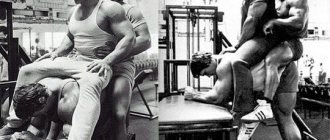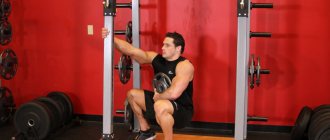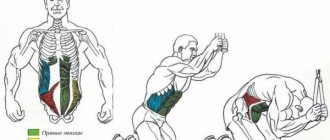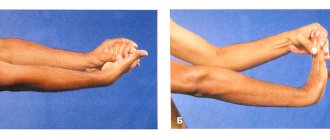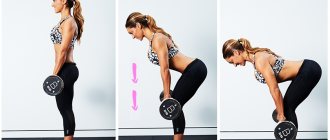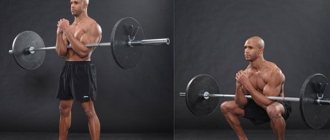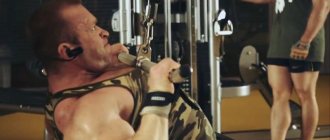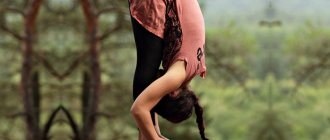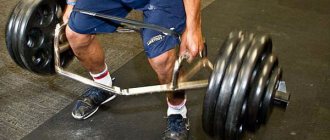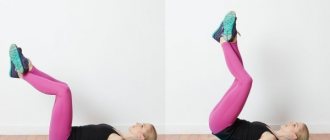What muscles work
By throwing the barbell over your shoulders, you engage the deltoids and arm muscles. Of the three bundles of our deltas, the front and middle ones work the most. Of the pectorals, their upper part. And from the muscles of the arms - triceps.
We considered only those muscles that are primarily responsible for pressing the apparatus upward. Shvungs would not be such if they did not involve the leg muscles. It is rising from a half-sitting position, due to the work of the quadriceps, that gives the weight an upward impulse, and allows you to lift a lot of weight. The trapezius and serratus muscles, contracting, keep the shoulder blades from falling and rotate them when raising the arms upward. And our core stabilizes the position of the body.
Alternatives – standing dumbbell press
There are plenty of alternatives to the classic bench press. In women's training, they often use seated presses on a fitball to turn on the stabilizers, but it is better to choose a simpler option to load them - just press a barbell or dumbbells while standing.
The second “alternative press” option is the kneeling position. It is intended strictly for those people who do not know how to use their legs and are constantly trying to shunt, that is, push the working weight by sharply bending the knees. This does not give the feeling of isolated work, and develops completely different qualities - explosive strength and footwork.
The standing dumbbell press option allows you to:
- Take more weights, as the body position is more stable and more natural for lifting weights;
- Develop stabilizers from the foot muscles to the core muscles;
- Promote the development of strength in barbell presses, cleans and jerks;
- Work in a plane natural to the human anatomy and do not damage the joints
A technique to stabilize the center of the body is used. The athlete strains his quadriceps, buttocks, as if he were pressing his feet into the floor, pulls the abdominal wall towards the spine, draws in the stomach and brings the shoulder blades together, lowering them towards the spine. At the same time, the trapezius and shoulders remain relaxed.
Technique
- The dumbbells are brought to the shoulders by standing up, that is, the knees are slightly bent and the weight is brought to the shoulders in one powerful movement;
- The athlete stabilizes the core as above;
- Due to extension in the shoulder and elbow joint, it moves the dumbbells upward;
- Lowers them smoothly to the shoulders;
- The peculiarity is that dumbbells move along a “flat” trajectory than a barbell;
- There is no need to bring them behind the head, as is emphasized in the movement with a barbell.
It's the STANDING DUMBELL PRESS, baby!
Watch this video on YouTube
Recommendations
- For bodybuilding and fitness purposes, it is not recommended to completely “stick” your elbows at the top point;
- You need to avoid a flat trajectory, and try to move the dumbbells slightly to the top of your head, and not to your forehead;
- Complete relaxation of the arms, as well as “releasing tension” from the center of the body by relaxing the abdomen, is not allowed;
- The weight for strength training is lifted no more than 5-6 repetitions, there should be no more than 5 approaches.
Errors:
- Shvung weight, that is, acceleration and pushing with the legs;
- Rocking the body back and forth;
- “Strong’s” technique” in which the athlete seems to “roll” the dumbbells onto his shoulders in each repetition, and “push” the dumbbells with his stomach and chest at the start
Dumbbells can be replaced with weights. In this case, you need to start from shoulder level, but your palms should be directed towards each other. In the process of moving upward, the projectiles turn, as in the Arnold press. Some athletes initially press with their palms facing forward, but this position is quite traumatic for the wrists.
The benefits and harms of exercise
The advantages of shvungs are obvious:
- The large number of muscles involved makes shvungi an energy-intensive exercise. Which is good at the stage of losing weight and when training strength endurance.
- Allows you to develop shoulder girdle strength. Heavy weight, provided the correct technique is used, will strengthen the ligamentous apparatus.
- Well, for those involved in weightlifting, shvungs will serve as an effective means of increasing athletic performance.
But there is a fly in the ointment:
- Shvungs, like other exercises with axial load, are not recommended for people with spinal diseases. But the main load goes to the shoulder joint, so if it is injured or diseased, movement should definitely be excluded.
- The exercise technique is not easy to master and requires considerable effort, and even better, a good mentor.
Weak deltoids? Press press to the rescue!
Shvungs are an excellent basic exercise borrowed from weightlifting. It allows you to perfectly work out the anterior (most massive) bundle of deltoid muscles, and in addition uses almost all other muscles of the body as auxiliary ones. This is why the push press helps develop overall strength and explosive speed.
The exercise is in many ways similar to the standing barbell chest press (or military press), and it is not without reason that many bodybuilders use it at the end of a standing press set. If an athlete is unable to press the weight without “cheating,” he begins to “squat” slightly, transferring some of the load from the deltoids to other muscle groups, which allows him to complete the last repetitions.
However, few people know that this exercise is completely independent, and even fewer people use it in their training. But practice shows that shvung helps increase shoulder strength and strength in other basic exercises.
Execution technique and exercise options
There are two types of shwung: press and push (classic). The first is technically simpler and places more emphasis on the shoulder girdle. While the second one better imitates a dip in a weightlifting clean and jerk.
Zhimovoy
The movement is similar to the standing press, but with some distinct differences. For example, here, when pressing the weight up, you help yourself with the help of your legs. And at the initial moment, the bar should not press on your palms, but lie on your shoulders. But first things first.
- Place the barbell on racks at a height just below your shoulders.
- Remove the barbell from the racks and place it on your shoulders in the area of the front delts. At the same time, your hands should still hold onto the bar.
- Holding the barbell in this position, squat to a quarter of the amplitude. Keep your back straight.
- With a powerful movement, stand up from the squat, giving the barbell an upward impulse. Pick up the momentum with your shoulder girdle and use the force of your shoulders and arms to press the barbell up.
- As the barbell moves upward, it will certainly encounter a chin along its path. But to prevent a collision from happening, it must be tilted back and the bar passed through.
- Lower the barbell only slightly, reducing the speed of its fall under the influence of its own gravity. Land it in the same place from which it began its upward movement.
Jog
This type of shvung reduces the load on the muscles of the shoulder girdle, but puts more strain on the ligaments. In addition, the legs do twice as much work.
Let's look at the technique:
- The position of the apparatus on the shoulders and the squat to squeeze it up are similar to the bench press version.
- After you get up from the squat and the bar goes up due to the impulse imparted to it, sit under it again. That is, instead of pressing it with the strength of the muscles of the shoulder girdle, you sit up, straightening your arms almost effortlessly.
- Now you need to stand up from a half-sitting position, keeping your arms straight.
- Receiving the barbell back onto the shoulders is again similar to the bench press version.
In order not to strain your imagination too much, watch a video with an overview of two variations of the exercise.
Shvung press with barbell
Shvung press with a barbell is a multi-joint exercise from weightlifting. Accumulates the workload in the anterior bundle of deltoid muscles and is intended to develop the overall strength potential of the shoulder muscles. Lifting a projectile in a press press can be done both from stoppers and from the floor. We will look at the more universal first option.
Execution technique
Initial position:
- Place the barbell on a vertical rack, adjusting the position of the stops at the level of your upper chest.
- Grasp the barbell with a closed grip, placing your hands slightly wider than shoulder-width apart.
- Remove the barbell from the racks and place it in front of your front delts and chest.
- Lower your elbows slightly downward, rolling the bar from your fingers to your palm.
- Place your feet hip-width apart with your toes pointing outward.
Movement:
- Taking a deep breath, lower yourself into a squat position, bending your knees and hips.
- Without pausing, come out of the squat with a powerful movement, simultaneously pushing the barbell straight up over your head and straightening your elbows completely.
- Hold the projectile above your head for a few seconds.
- Lower the barbell to your chest by squatting slightly at the same time, and then straightening your legs again.
Attention!
- Do not move the bar back behind your back or too far forward.
- Straighten your elbows at the top of the movement.
- Don't sit too deep.
- Perform the press without delay or pause.
Recommendations!
- Moving the bar back or forward changes the center of gravity and reduces core stability. With the correct technique, the projection of the barbell should pass through the center of the shoulder and hip joints and feet. A slight deviation of the arms with the projectile back is acceptable, provided there is good mobility of the shoulder joints.
- In the finishing position, the projectile is held above the head with fully extended arms.
- When squatting, your knees should “diverge” to the sides. For this purpose, pay attention to the position of the toes of the feet - they should not be parallel, but slightly turned outward.
- Some people mistakenly assume that the effectiveness of the pressing movement is determined by the depth of the squat. In reality, the force of the barbell’s “exit” depends on the final speed of straightening the legs, so a short squat is optimal.
- The barbell press should be a uniformly accelerated and continuous movement: the initial acceleration of the barbell is set by exiting the squat, the further part of the amplitude of movement of the projectile is overcome by pressing with the hands.
Execution options
- Overhead press press. In this version, the barbell is located not on the shoulders, but on the trapezius muscles. The technical design of the element is no different from the original, but is more anatomically advantageous from the point of view of the natural position of the center of gravity. Allows you to use more weight due to a reduced amplitude.
- Push shvung. The active phase of the movement is almost identical to the pressing pattern. However, instead of pressing the projectile with the delta and triceps, as in the version with the push press, the athlete goes under the bar and “receives” the projectile with straight arms, pressing the weight with his legs. This version of the shwung puts less strain on the arm muscles, allowing you to perform the movement with greater weight.
Video Shvung Press
Video Shwung press with a barbell for girls
Analysis of the exercise
The push press is an exercise from the weightlifting arsenal. In the training of weightlifters, the shwung is used as an auxiliary movement for teaching the technique of pushing, and by athletes from related disciplines it is used to develop mass and explosive strength of the target muscles. The movement is classified as multi-joint, complexly involving a large muscular cascade.
The main functional load is assumed by the anterior deltoids and the upper part of the pectoralis major muscle.
Additionally, the movement involves:
- quadriceps femoris muscle
- triceps;
- serratus anterior muscle.
- trapezius muscle.
In training practice, this exercise is an alternative to the chest press, but differs in the ability to use a squat to accelerate the projectile. The use of a forceful “thrust” allows you to perform a pressing movement with greater weight.
Proper execution
- In the final position, the arms with the barbell should be fully straightened and fixed above the head.
- The elbows should be brought forward and as close to the body as possible.
- Keep your body upright - this makes it possible to concentrate maximum load on your shoulders and reduces the likelihood of injury.
- The pressing movement begins with an explosive lift of the pelvis and is supported by arm strength.
- At the final point of lifting the bar, the projectile should “pass” through an imaginary line in the middle of the body - from the top of the head to the feet.
- When doing the chest press, remember to move your head back so as not to interfere with the upward movement of the barbell.
Errors
- Lowering the elbows at the moment of squatting.
- Bringing your knees forward when lowering into a squat.
- Rounding the back.
- Uncoordinated movement of the legs and arms when pushing the projectile upward.
- Lack of cushioning when the barbell returns to the chest.
- The squat is too deep.
Recommendations
- The most universal grip from the point of view of physiological convenience and the ability to work with substantial weight is considered to be a grip slightly wider than the shoulders – 5-10 cm.
- During the negative phase, the elbows should be “pushed” forward, moving beyond the line of the bar. This ensures that the projectile is fixed by the front deltas and is accurately returned to its original position.
- The squat in the shvung should not be deep - it is enough to go down to ¼ of the squat amplitude.
- For better shock absorption when lowering the barbell to your chest, bend your knees.
- The faster you come out of the squat, the more weight you can handle.
- The push press requires constant contact of the foot with the floor.
Inclusion in the program
Considering the nature of the load, it is advisable to include the push press in a strength program to work the shoulder muscles. It is usually ranked number one because it is a difficult exercise.
But some people prefer an alternative option - “shung” after performing a military press. After completing a series of sets of the main exercise, the athlete can use a shock press, which allows for an element of cheating. And thereby load the target muscles more strongly. Typically, shvung is performed for 6-10 repetitions in 3 sets.
When it comes to the specific training of weightlifters, the shvung is performed in 1-3 repetitions with 70% of 1RM (repetition maximum) by experienced athletes or with a low weight to disassemble the movement technique for beginners.
Contraindications
It is recommended to exclude the push press from the program for athletes suffering from pain in the lumbar region, protrusions, osteochondrosis or varicose veins. An absolute contraindication to performing the exercise is injuries to the shoulder joints.
Beginning athletes need to learn a complex movement only under the supervision of a coach, but first of all, ideally, work out the technique of classic standing presses.
Muscle map
Source: upraznenia.ru
This is interesting: Barbell cleans: technique for performing a basic exercise, recommendations and tips for using barbell cleans
Example workout
At home
If you are involved in CrossFit or weightlifting at an amateur level and want to do a workout at home, then having free weights is a must-have. But it doesn't have to be a barbell. You can use dumbbells or weights as weights.
Unlike a barbell, these exercises cannot be placed on the shoulders, so you need to perform them with extreme caution. When performing a movement with a dumbbell or kettlebell, your palms should be turned towards each other.
What a workout might look like:
- Shwung press with dumbbells – 3-4 sets of 6-8 reps.
- Shvung push – 3-4 sets of 6-8 repetitions.
In the first exercise, you focus on the muscles of the shoulder girdle and arms, and in the second, you load your legs and practice the squatting technique.
In the gym
Within the walls of the hall you will already have a barbell at your disposal, the news cannot but rejoice!
The training can go like this:
- Shvung with a bench press bar – 3-4 sets of 6-8 reps.
- Push push – 3-4 sets of 6-8 reps.
As you can see, the essence of the workout is the same as at home.
Push shwung
A sport such as weightlifting requires a certain approach and adherence to basic rules. This is not an easy type of exercise; you need to be able to correctly use the right muscles of the body to avoid injury during exercise.
Let's take a closer look at what a push push is, how it differs from a bench press, replacing a barbell, and what muscles are involved. The most important thing is the execution technique; the result depends on the technique.
Correct execution of the push
In weightlifting, there are terms like push-and-jerk and push-press. Despite the similarity of their load on the same muscles, they have their own characteristics and rules.
Jogging - has the ability to immediately give a significant load. The technique of execution consists not only of lifting the weight above your head, but also of repeated squatting, in which you need to push down from the weight load. This CrossFit exercise allows the muscles to be in constant tension, although at first glance it may seem that they are relaxed during a squat.
A misleading opinion... at this moment they should be as tense as possible for further correct sequence.
The order is as follows:
- Starting position: feet hip-width apart, weight on heels.
- Keep your body straight, elbows forward, arms slightly wider than shoulders, weight resting on your shoulders.
- Perform a shallow squat, moving the body vertically.
- Extend your legs sharply, pushing out the barbell.
- When the bar rises above the bridge of your nose, squat underneath it, moving your hips back, ending in a partial squat position.
- Stand with your knees and hips fully straight and lower the barbell onto your shoulders.
In short, it all happens this way: squat, press the barbell up, squat under the bar, exit from the squat. The key is to fully straighten your hips before doing the squat.
Muscle work
In shvung, the muscles of the legs, arms, and abs play an important role. A well-trained abs is essential for many sports. For training with a barbell, its role far exceeds its significance.
Fixation above the head and its correct support, the press at this moment should take on the load as much as possible. During training, all muscles are interconnected - each plays its own role, they are equally important for proper CrossFit.
Nuances
Regardless of whether the push is a press or a push, they require significant effort to perform. If we compare these seemingly similar exercises at some points, then the push, unlike the bench press, requires 30% more effort during actions.
This occurs due to the fact that each subsequent squat goes deeper and at the moment of lifting the weight. Compared to the bench press, the clean and jerk is much more suitable for rapid physical development of the body. During the push press - a squat with a quick bend of the pelvic part, a thrust associated with the rapid straightening of the pelvis, a final booster. When pushing, it requires a lot more force. The main thing is a well-pumped abs and legs (a lot has been written about their training in the article: how to pump up your legs), the correct placement of your hands.
To begin with, it is enough to lift a weight of 45 kilograms. To achieve the desired result as quickly as possible, it is advisable to do push-ups 15 times, then a break of 30 seconds, repeat the same pattern 5-6 times. Depending on the result, the load should be increased only after it is possible to do the required number of repetitions with a short break between approaches, in the absence of pauses after the push.
Worthy replacement
Exercises in CrossFit with a barbell can be replaced with kettlebells, and the result will be no worse. You can do push-pull with one or two weights. These exercises have their own rules and sequence.
Single kettlebell workout:
- Starting position: legs shoulder-width apart, feet relaxed and directed slightly to the sides, back straight.
- This is followed by a chest lift - a sharp movement using a rocking pelvis that helps lift the weight.
- Do the push in the same way as with a barbell.
When the weight is above your head, you need to straighten up completely, lower the weight to your chest and repeat.
In the case of training with two, there are nuances that significantly affect the correctness of its implementation. Subsequence:
- The starting position of the body is the same as with the exercise with one.
- Raise the weights to your chest and begin the movement by rocking your pelvis, slightly tilting your body back to catch the weight and make a swing.
- Push the weights up while going into the squat position. You need to keep your back straight and direct the weight upward, and not in an arc - otherwise, you can lose your balance and get up from a crouch.
- You need to fix the raised weights above your head with outstretched arms, while standing up from a squat.
We see that the main mistake of training with two weights may lie in their wrong direction. It is important that the back is sufficiently trained to maintain the correct position during various exercises and avoid injury.
Conclusion
Regardless of what kind of sport a person is interested in, it is worth following certain rules of this sport. The push-up technique requires a certain approach and fairly well-trained muscle mass. During sports, you can get various types of injuries, to avoid this, you must strictly follow the rules of sequence.
Before a person decides to take up or switch to weightlifting, he must be well prepared and understand that increasing muscle mass by lifting heavy objects is not so easy. First, you should train your abs, legs and arms well enough, familiarize yourself with the full technique of execution, and be sure to take into account possible mistakes at the beginning. It depends on them how quickly the result will come. Many people make the global mistake that the speed of CrossFit is wrong. This all only leads to injury and forced possible treatment.
You can’t suddenly start training by lifting a lot of weight; you need to approach these workouts comprehensively and start small, listen to the advice of experienced athletes who know the rules and may have made mistakes at the beginning. Now they can use their mistakes to help a beginner avoid them.
Each sport has its own advantages, the main thing is to know how to make sure that the risk of injury is minimal. Play sports, be careful, and remember - any sport has its own nuances and requirements, observing them is an integral part of training, and the result depends on each individual.
Get better and stronger with bodytrain.ru
Read other articles in the blog's knowledge base.
Related posts:
Australian pull-ups
What muscle groups are worked on an elliptical trainer?
Concentrated biceps curl
Raider Row Source: bodytrain.ru
Tips for implementation
Equipment
Since the exercise is aimed at strengthening the ligaments and tendons of the shoulder girdle and arms, it is worth equipping everything except these parts of the body. The only exception is the hands, which should be bandaged with wrist straps.
A weightlifting belt can be used to support the lumbar region.
On larger scales, you can wrap your knee joints using knee wraps. But you don't need to use a tight bandage like in powerlifting.
Sets and reps
You should not expect impressive muscle hypertrophy (increase in the volume of muscle fibers) from shvungs. The exercise has a different purpose - strengthening the ligamentous apparatus and increasing muscle strength. Therefore, the repetition range should not exceed 6-8 repetitions. And if you are well trained, it is better to stick to the 2-5 rep range.
The fewer repetitions you perform in a set, the more sets you should perform. For 6-8 repetition training – 3-4 approaches, for low repetition training (2-5) – up to 5-6 approaches. Moreover, in the second case, rest should be increased to 2-3 minutes.
Nuances
It is important to prepare properly for training, including clothing. Proper equipment is important for training. Since shungis are a forceful method of strengthening ligaments and tendons, clothing matters. This means that equipment is needed for everything except the parts of the body involved.
The exception is the hands, which must be bandaged with straps. You can wear a special belt on the lumbar region, which is worn by weightlifters. When lifting weights, it is worth bandaging your knee joints. However, you should not make the bandage too tight.
Common mistakes
Shvungs are by no means the most technically simple exercise. Mastering, especially the push version, sometimes requires months of training and, preferably, the participation of a competent trainer.
Those who decide to study on their own usually make the following mistakes:
- They perform military presses instead of push-ups, completely forgetting about footwork.
- When performing the bench press version, they sit under the barbell, relieving the load from the shoulders.
- Slowly lower the weight down and do not absorb its landing with a small half-squat.
- Do not straighten your arms at the elbows, keeping them slightly bent.
- Bend your back to make it easier to press the bar by connecting your chest to the work.
- They neglect warm-up or spend insufficient time on it.
All of these mistakes can ultimately lead to injury and a long absence from your training schedule. So be careful, friends!
Conclusion
Today we looked at a difficult exercise that is rarely found in gyms. As a rule, it is used by representatives of power sports. If you are not one of those, then this exercise is most likely of no use to you. Although you can easily diversify your workouts by adding it to your program, just contact a professional to set up the technique!
That's all for today. Subscribe to article updates and share useful information with your friends. See you soon!
